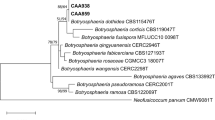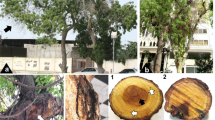Abstract
Eucalyptus globulus, a non-native species, is currently the most abundant forest species in Portugal. This economically important forest tree is exploited mainly for the production of pulp for the paper industry. The community of Botryosphaeriaceae species occurring on diseased and healthy E. globulus trees was studied on plantations throughout the country. Nine species from three different genera were identified, namely Botryosphaeria (B. dothidea), Diplodia (D. corticola and D. seriata) and Neofusicoccum (N. australe, N. algeriense, N. eucalyptorum, N. kwambonambiense, N. parvum and Neofusicoccum sp.). Of these, N. algeriense, D. corticola and D. seriata are reported for the first time on E. globulus, while N. algeriense, N. eucalyptorum and N. kwambonambiense correspond to first reports in Portugal. The genus Neofusicoccum was clearly dominant with N. australe and N. eucalyptorum being the most abundant species on both diseased and healthy trees. In artificial inoculation trials representative isolates from all nine species were shown to be pathogenic to E. globulus but there were marked differences in aggressiveness between them. Thus, D. corticola and N. kwambonambiense were the most aggressive while B. dothidea and D. seriata were the least aggressive of the species studied.


Similar content being viewed by others
References
Alves, A., Barradas, C., Phillips, A. J. L., & Correia, A. (2013). Diversity of Botryosphaeriaceae species associated with conifers in Portugal. European Journal of Plant Pathology, 135, 791–804.
Alves, A., Correia, A., Luque, J., & Phillips, A. J. L. (2004). Botryosphaeria corticola sp. nov. on Quercus species, with notes and description of Botryosphaeria stevensii and its anamorph Diplodia mutila. Mycologia, 96, 598–613.
Alves, A., Linaldeddu, B. T., Deidda, A., Scanu, B., & Phillips, A. J. L. (2014). The complex of Diplodia species associated with Fraxinus and some other woody hosts in Italy and Portugal. Fungal Diversity, 67(1), 143–156.
Alves, A., Phillips, A. J. L., Henriques, I., & Correia, A. (2007). Rapid differentiation of species of Botryosphaeriaceae by PCR fingerprinting. Research in Microbiology, 158, 112–121.
Armengol, J., Gramaje, D., Perez-Sierra, A., Landeras, E., Alzugaray, R., Luque, J., & Martos, S. (2008). First report of canker disease caused by Neofusicoccum australe on Eucalyptus and pistachio in Spain. Plant Disease, 92, 980.
Barber, P. A., Burgess, T. J., Hardy, G. E., Slippers, B., Keane, P. J., & Wingfield, M. J. (2005). Botryosphaeria species from Eucalyptus in Australia are pleoanamorphic, producing Dichomera synanamorphs in culture. Mycological Research, 109(12), 1347–1363.
Begoude, B. A. D., Slippers, B., Wingfield, M. J., & Roux, J. (2010). Botryosphaeriaceae associated with Terminalia catappa in Cameroon, South Africa and Madagascar. Mycological Progress, 9(1), 101–123.
Berraf-Tebbal, A., Guerreiro, M. A., & Phillips, A. J. L. (2014). Phylogeny of Neofusicoccum species associated with grapevine trunk diseases in Algeria, with description of Neofusicoccum algeriense sp. nov. Phytopathologia Mediterranea, 53(3), 416–427.
Bettucci, L., & Saravay, M. (1993). Endophytic fungi in Eucalyptus globulus: a preliminary study. Mycological Research, 97, 679–682.
Bettucci, L. & Alonso, R. (1997). A comparative study of fungal populations in healthy and symptomatic twigs of Eucalyptus grandis in Uruguay. Mycological Research, 101(9), 1060–1064.
Burgess, T. I., Barber, P. A., & Hardy, G. E. S. J. (2005). Botryosphaeria spp. associated with eucalypts in Western Australia, including the description of Fusicoccum macroclavatum sp. nov. Australasian Plant Pathology, 34, 557–567.
Burgess, T. I., Sakalidis, M. L., & Hardy, G. E. S. J. (2006). Gene flow of the canker pathogen Botryosphaeria australis between Eucalyptus globulus plantations and native eucalypt forests in Western Australia. Austral Ecology, 31, 559–566.
Carbone, I., & Kohn, L. M. (1999). A method for designing primer sets for speciation studies in filamentous ascomycetes. Mycologia, 91, 553–556.
Chen, S. F., Pavlic, D., Roux, J., Slippers, B., Xie, Y. J., Wingfield, M. J., & Zhou, X. D. (2011). Characterization of Botryosphaeriaceae from plantation-grown Eucalyptus species in South China. Plant Pathology, 60, 739–751.
Chungu, D., Muimba-Kankolongo, A., Wingfield, M. J. & Roux, J. (2010). Identification of fungal pathogens occurring in eucalypt and pine plantations in Zambia by comparing DNA sequences. Forestry, 83(5), 507–515.
Gezahgne, A., Roux, J., Slippers, B., & Wingfield, M. J. (2004). Identification of the causal agent of Botryosphaeria stem canker in Ethiopian Eucalyptus plantations. South African Journal of Botany, 70(2), 241–248.
ICNF, (2013). IFN6 – Áreas dos usos do solo e das espécies florestais de Portugal continental. Resultados preliminares. [pdf], 34 pp. Instituto da Conservação da Natureza e das Florestas. Lisboa.
Iturritxa, E., Slippers, B., Mesanza, N., & Wingfield, M. J. (2011). First report of Neofusicoccum parvum causing canker and die-back of Eucalyptus in Spain. Australasian Plant Disease Notes, 6, 57–59.
Linaldeddu, B. T., Scanu, B., Maddau, L., & Franceschini, A. (2014). Diplodia corticola and Phytophthora cinnamomi: the main pathogens involved in holm oak decline on Caprera Island (Italy). Forest Pathology, 44(3), 191–200.
Lynch, S. C., Eskalen, A., Zambino, P. J., Mayorquin, J. S., & Wang, D. H. (2013). Identification and pathogenicity of Botryosphaeriaceae species associated with coast live oak (Quercus agrifolia) decline in southern California. Mycologia, 105(1), 125–140.
Mohali, S. R., Slippers, B., & Wingfield, M. J. (2007). Identification of Botryosphaeriaceae from Eucalyptus, Acacia and Pinus in Venezuela. Fungal Diversity, 25, 103–125.
Mohali, S. R., Slippers, B., & Wingfield, M. J. (2009). Pathogenicity of seven species of the Botryosphaeriaceae on Eucalyptus clones in Venezuela. Australasian Plant Pathology, 38, 135–140.
Page, R. D. (1996). TreeView: an application to display phylogenetic trees on personal computers. Computer Applications in the Biosciences, 12, 357–358.
Pavlic, D., Slippers, B., Coutinho, T. A. & Wingfield, M.J. (2007). Botryosphaeriaceae occurring on native Syzygium cordatum in South Africa and their potential threat to Eucalyptus. Plant Pathology, 56, 624–636.
Pavlic, D., Slippers, B., Coutinho, T. A., & Wingfield, M. J. (2009a). Multiple gene genealogies and phenotypic data reveal cryptic species of the Botryosphaeriaceae: A case study on the Neofusicoccum parvum/N. ribis complex. Molecular Phylogenetics and Evolution, 51(2), 259–268.
Pavlic, D., Slippers, B., Coutinho, T. A., & Wingfield, M. J. (2009b). Molecular and phenotypic characterization of three phylogenetic species discovered within the Neofusicoccum parvum/N. ribis complex. Mycologia, 101(5), 636–647.
Pérez, C. A., Wingfield, M. J., Slippers, B., Altier, N. A., & Blanchette, R. A. (2009). Neofusicoccum eucalyptorum, a Eucalyptus pathogen, on native Myrtaceae in Uruguay. Plant Pathology, 58(5), 964–970.
Pérez, C. A., Wingfield, M. J., Slippers, B., Altier, N. A., & Blanchette, R. A. (2010). Endophytic and canker-associated Botryosphaeriaceae occurring on non-native Eucalyptus and native Myrtaceae trees in Uruguay. Fungal Diversity, 41(1), 53–69.
Phillips, A. J. L., Alves, A., Abdollahzadeh, J., Slippers, B., Wingfield, M. J., Groenewald, J. Z., & Crous, P. W. (2013). The Botryosphaeriaceae: genera and species known from culture. Studies in Mycology, 76, 51–167.
Phillips, A. J. L., Alves, A., Correia, A., & Luque, J. (2005). Two new species of Botryosphaeria with brown, 1-septate ascospores and Dothiorella anamorphs. Mycologia, 97, 513–529.
Phillips, A. J. L., Lopes, J., Abdollahzadeh, J., Bobev, S., & Alves, A. (2012). Resolving the complex of Diplodia species on apple and other Rosaceae hosts. Persoonia, 29, 29–38.
Pillay, K., Slippers, B., Wingfield, M. J., & Gryzenhout, M. (2013). Diversity and distribution of co-infecting Botryosphaeriaceae from Eucalyptus grandis and Syzygium cordatum in South Africa. South African Journal of Botany, 84, 38–43.
Rodas, C. A., Slippers, B., Gryzenhout, M., & Wingfield, M. J. (2009). Botryosphaeriaceae associated with Eucalyptus canker diseases in Colombia. Forest Pathology, 39, 110–123.
Ronquist, F. R., & Huelsenbeck, J. P. (2003). MrBayes3: Bayesian phylogenetic inference under mixed models. Bioinformatics, 19, 1572–1574.
Sakalidis, M. L., Hardy, G. E. S. J., & Burgess, T. I. (2011). Use of the Genealogical Sorting Index (GSI) to delineate species boundaries in the Neofusicoccum parvum–Neofusicoccum ribis species complex. Molecular Phylogenetics and Evolution, 60, 333–344.
Sakalidis, M. L., Slippers, B., Wingfield, B. D., Hardy, G. E. S. J., & Burgess, T. I. (2013). The challenge of understanding the origin, pathways and extent of fungal invasions: global populations of the Neofusicoccum parvum–N. ribis species complex. Diversity and Distributions, 19(8), 873–883.
Silva, M., Machado, H., & Phillips, A. J. L. (2009). Mycosphaerella species occurring on Eucalyptus globulus in Portugal. European Journal of Plant Pathology, 125(3), 425–433.
Slippers, B., Burgess, T., Pavlic, D., Ahumada, R., Maleme, H., Mohali, et al. (2009). A diverse assemblage of Botryosphaeriaceae infect Eucalyptus in native and non-native environments. Southern Forests: a Journal of Forest Science, 71, 101–110.
Slippers, B., Crous, P. W., Denman, S., Coutinho, T. A., Wingfield, B. D., & Wingfield, M. J. (2004a). Combined multiple gene genealogies and phenotypic characters differentiate several species previously identified as. Botryosphaeria dothidea. Mycologia, 96(1), 83–101.
Slippers, B., Fourie, G., Crous, P. W., Coutinho, T. A., Wingfield, B. D., Carnegie, A. J., & Wingfield, M. J. (2004b). Speciation and distribution of Botryosphaeria spp. on native and introduced Eucalyptus trees in Australia and South Africa. Studies in Mycology, 50, 343–358.
Slippers, B., Johnson, G. I., Crous, P. W., Coutinho, T. A., Wingfield, B. D., & Wingfield, M. J. (2005). Phylogenetic and morphological re-evaluation of the Botryosphaeria species causing diseases of Mangifera indica. Mycologia, 97(1), 99–110.
Slippers, B., & Wingfield, M. J. (2007). Botryosphaeriaceae as endophytes and latent pathogens of woody plants: diversity, ecology and impact. Fungal Biology Reviews, 21, 90–106.
Smith, H., Crous, P. W., Wingfield, M. J., Coutinho, T. A., & Wingfield, B. D. (2001). Botryosphaeria eucalyptorum sp. nov., a new species in the B. dothidea-complex on Eucalyptus in South Africa. Mycologia, 93(2), 277–285.
Smith, H., Kemp, G. H. J., & Wingfield, M. J. (1994). Canker and die-back of Eucalyptus in South Africa caused by Botryosphaeria dothidea. Plant Pathology, 43, 1031–1034.
Smith, H., Wingfield, M. J., & Petrini, O. (1996). Botryosphaeria dothidea endophytic in Eucalyptus grandis and Eucalyptus nitens in South Africa. Forest Ecology and Management, 89, 189–195.
Sousa da Câmara, M. E. (1929). Contributiones ad mycofloram Lusitaniae. Centuriae VIII et IX. Anais do Instituto Superior de Agronomia, 3, 59–141.
Sutton, B. C., & Dyko, B. J. (1989). Revision of Hendersonula. Mycological Research, 93, 466–488.
Tamura, K., Stecher, G., Peterson, D., Filipski, A., & Kumar, S. (2013). MEGA6: Molecular Evolutionary Genetics Analysis version 6.0. Molecular Biology and Evolution, 30, 2725–2729.
Taylor, K., Barber, P. A., Hardy, G. E. S. J., & Burgess, T. J. (2009). Botryosphaeriaceae from tuart (Eucalyptus gomphocephala) woodland, including descriptions of four new species. Mycological Research, 113, 337–353.
Thompson, J. D., Gibson, T. J., Plewniak, F., Jeanmougin, F., & Higgins, D. G. (1997). The ClustalX windows interface: flexible strategies for multiple sequence alignment aided by quality analysis tools. Nucleic Acids Research, 25, 4876–4882.
Úrbez-Torres, J. R., Peduto, F., Rooney-Latham, S., & Gubler, W. D. (2010). First report of Diplodia corticola causing grapevine (Vitis vinifera) cankers and trunk cankers and dieback of Canyon Live Oak (Quercus chrysolepis) in California. Plant Disease, 94(6), 785.
Varela, C. P., Fernández, V. R., Casal, O. A., & Vázquez, J. P. M. (2011). First report of cankers and dieback caused by Neofusicoccum mediterraneum and Diplodia corticola on grapevine in Spain. Plant Disease, 95(10), 1315.
White, T. J., Bruns, T., Lee, S., & Taylor, J. (1990). Amplified and direct sequencing of fungal ribosomal RNA genes for phylogenies. In M. A. Innis, D. H. Gelfand, J. J. Sninsky, & T. J. White (Eds.), PCR protocols: A guide to methods and applications (pp. 315–322). San Diego: Academic Press.
Acknowledgments
This work was financed by European Funds through COMPETE and by National Funds through the Portuguese Foundation for Science and Technology (FCT) within project PANDORA (PTDC/AGR-FOR/3807/2012 – FCOMP-01-0124-FEDER-027979). The authors acknowledge FCT financing to CESAM (UID/AMB/50017/2013), Artur Alves (FCT Investigator Programme – IF/00835/2013) and Carla Barradas (PhD grant –SFRH/BD/77939/2011). The authors are thankful to Altri Florestal, SA for supplying diseased plant material from their plantations as well as the E. globulus clone used for pathogenicity trials.
Author information
Authors and Affiliations
Corresponding author
Rights and permissions
About this article
Cite this article
Barradas, C., Phillips, A.J.L., Correia, A. et al. Diversity and potential impact of Botryosphaeriaceae species associated with Eucalyptus globulus plantations in Portugal. Eur J Plant Pathol 146, 245–257 (2016). https://doi.org/10.1007/s10658-016-0910-1
Accepted:
Published:
Issue Date:
DOI: https://doi.org/10.1007/s10658-016-0910-1




